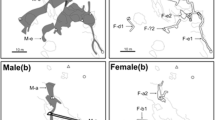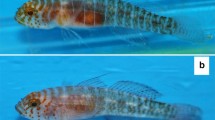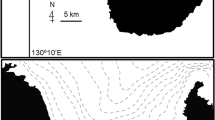Abstract
Reproductive behavior and mate fidelity of the gobiid fish,Valenciennea longipinnis, were studied on the coral reef at Sesoko Island, Okinawa, Japan. These fish usually live in pairs, not only foraging together for benthic animals in sandy areas, but also constructing several burrows within their home range. Before spawning, both fish, although mainly the male, constructed a mound, piling up dead-coral fragments, pebbles, shells, sand and algae onto one of the burrows. After spawning an egg mass on the ceiling of the burrow, the female stayed outside and continued the construction and maintenance of the mound for 3–5 days until hatching, while the male tended the eggs inside. Mate guarding of females seemed to prevent males from monopolizing several females. Although some pairs showed mate fidelity through several spawnings, more than half of the pairs broke up after only one spawning. The pair bond was broken by mate desertion and the disappearance of each sex. Both sexes preferred larger spawning partners; larger females spawned more eggs and larger males provided better egg care. Mate desertion occurred when larger potential mates, relative to the current partner, became available. The frequency of solitary individuals was higher in males than in females, resulting in females deserting their mates more often than males. Two factors seem to have facilitated mate desertion: (1) occurrence of size mis-matched pairing and (2) overlapping home ranges.
Similar content being viewed by others
Literature Cited
Anderson, M. 1994. Sexual selection. Princeton University Press, New York, xx+599 pp.
Barlow, G. W. 1984. Patterns of monogamy among teleost fishes. Arch. Fisch Wiss., 35: 75–123.
Barlow, G. W., 1987. Spawning, eggs and larvae of the long-none filefish,Oxymonacanthus longirostris, a monogamous coralivore. Env. Biol. Fish., 20: 183–194.
Bateman, A. J. 1948. Intra-sexual selection inDrosophila. Heredity, 2: 349–368.
Birkhead, T. R. and A. P. Møller 1992. Sperm competition in birds: evolutionary causes and consequences. Academic Press, London. x+282 pp.
Breder, C. M. and D. E. Rosen 1966. Modes of reproduction in fishes. Nat. hist. Press, Garden City, New York. 941 pp.
Davies, N. B. 1991. Mating systems, Pages 263–294,in J. R. Krebs and N. B. Davies, eds. Behavioral ecology: an evolutionary approach. 3rd edition. Blackwell Scientific Publications, Oxford.
Emlen, S. T. and L. W. Oring 1977. Ecology, sexual selection, and the evolution of mating systems. Science, 197: 215–223.
Hannon, S. J. 1984. Factors limiting polygyny in willow ptarmigan. Anim. Behav., 32: 153–161.
Huettel, M., W. Ziebis and S. Forster. 1996. Flow-induced uptake of particulate matter in permeable sediments. Limnol. Oceanogr., 41: 309–322.
Keenleyside, M. H. A. 1983. Mate desertion in relation to adult sex ratio in the biparental cichlid fishHerotilapia multispinosa. Anim. Behav., 31: 683–688.
Kuwamura, T., Y. Yogo and Y. Nakashima 1993. Size-assortative monogamy and paternal egg care in a coral gobyParagobiodon echinocephalus. Ethology, 95: 65–75.
Lack, D. 1968. Ecological adaptations for breeding in birds. Chapman and Hall, London. 409 pp.
Martin, K., F. G. Cooch, R. F. Rockwell and F. Cooke. 1985. Reproductive performance in lesser snow geese: are two parents essential? Behav. Ecol. Sociobiol., 17: 257–263.
Martin, K. and F. Cooke. 1987. Bi-parental care in willow ptarmigan: a luxury? Anim. Behav., 35: 369–379.
Pressley, P. H. 1981. Pair formation and joint territoriality in a simultaneous hermaphrodite: the coral reef fishSerranus tigrinus. Z. Tierpsychol., 56: 33–46.
Reavis, R. H. 1997. The natural history of a monogamous coral-reef fish,Valenciennea strigata (Gobiidae): 2. behavior, mate fidelity and reproductive success. Env. Biol. Fish., 49: 247–257.
Sano, M., M. Shimizu and Y. Nose 1984. Food habits of teleostean reef fishes in Okinawa Island, southern Japan. Univ. Mus., Univ. Tokyo, Bull., 25: 1–128.
Shiobara, Y. and Y. Tanaka 1995. Reproductive behavior, development of eggs and larvae of the gobiid fish,Valencienna bella, reared in the aquarium. J. Fac. Mar. Sci. Technol., Tokai Univ., 39: 207–220. (In Japanese with English abstract).
Shulman, M. J. 1985. Coral reef fish assemblages: intra- and interspecific competition for shelter sites. Env. Biol. Fish., 13: 81–92.
St. John, J., G. P. Jones and P. F. Sale 1989. Distribution and abundance of soft-sediment meiofauna and a predatory goby in a coral reef lagoon. Coral Reefs, 8: 51–57.
Sunobe, T. and A. Nakazono 1990. Polygynous mating system ofTrimma okinawae (Pisces: Gobiidae) at Kagoshima, Japan with a note on sex change. Ethology, 84: 133–143.
Tanaka, Y., K. Suzuki and A. Doi 1982. Reproduction and early life history of the gobioid fish,Eleotriodes helsdingeni Bleeker. J. Fac. Mar. Sci. Technol., Tokai Univ., 15: 367–376. (In Japanese with English abstract.)
Thresher, R. E. 1984. Reproduction in reef fishes. T. F. H. Publications, Neptune City, 399 pp.
Trivers, R. L. 1972. Parental investment and sexual selection. Pages 136–179in B. Campbell, ed. Sexual selection and the descent of man. Aldine, Chicago.
Turner, G. F. 1993. Teleost mating behaviour. Pages 307–331in T. J. Pitcher, ed. Behaviour of teleost fishes. 2nd edition. Chapman & Hall, London.
Warner, R. R. 1987. Female choice of sites versus mates in a coral reef fish,Thalassoma bifasciatum. Anim. Behav., 35: 1470–1478.
Yoshino, T. 1984. GenusValenciennea. Pages 242–243in H. Masuda, K. Amaoka, C. Araga, T. Uyeno and T. Yoshino, eds. the fishes of the Japanese Archipelago. English text. Tokai Univ. Press, Tokyo, xxii+437 pp.
Author information
Authors and Affiliations
About this article
Cite this article
Takegaki, T., Nakazono, A. Reproductive behavior and mate fidelity in the monogamous goby,Valenciennea longipinnis . Ichthyological Research 46, 115–123 (1999). https://doi.org/10.1007/BF02675429
Received:
Revised:
Accepted:
Issue Date:
DOI: https://doi.org/10.1007/BF02675429




